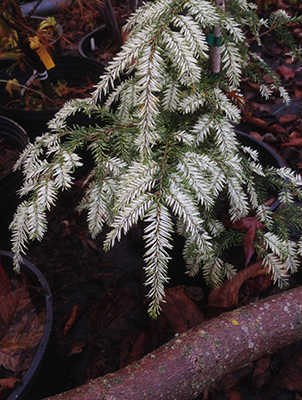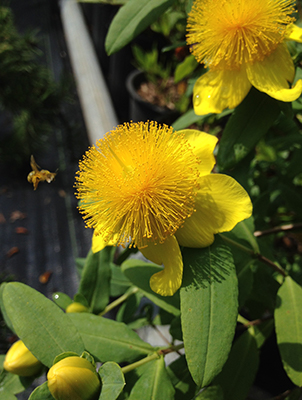Story by Michelle Sutton; photos courtesy of Coldwater Pond Nursery
When third-generation nurseryman and plant propagator Ted Hildebrant was ready to open his own nursery in the early 1990s, land in his native New Jersey was too expensive. A friend living in Wayne County encouraged him to have a look at the more affordable farmland for sale in the Finger Lakes.

“My goal at that point was to be a bare root tree grower,” Ted says, “so I spent hours upon hours walking the farms with my shovel, digging holes to evaluate the soil. In so many places, the ground was stony—not fit for field-grown trees.” At the last farm he visited on his third scouting trip to the Finger Lakes, Ted found his land-match in Phelps in Ontario County. The property possessed an ideal, mostly stone-free sandy loam, a large pond for irrigation, and several barns in good shape.
This would be Coldwater Pond Nursery, with a twist: one of the buildings was an operating poultry barn, and Ted accepted the seller’s offer to include the poultry business in the transaction. This decision would prove personally fruitful for Ted. Fourteen years ago, he hired Elly Keyel to help with the poultry barn; after a year and a half, Ted and Elly became partners in business and life.
As the nursery sales grew steadily over the years, Ted and Elly eventually let the poultry enterprise go. “It was nice to have the year-round cash-flow of that business to help build the nursery, and we liked working with the chicks, but it was very labor-intensive, and the margin of profit was slim,” Ted says.
The nursery’s business model has morphed in other ways over time. Today, Coldwater Pond Nursery is about 50 percent contract propagation—grafting scions onto rootstocks to sell to other growers—and about 50 percent producing rare and unusual plants for retail sale, mostly at farmer’s markets and garden show plant sales. (Ted and Elly travel to sell plants and give talks in Buffalo, Rochester, and Ithaca, as well as in Connecticut, Pennsylvania, and Ohio.)
“It’s still on my mind to explore bare root tree field production of trees we graft ourselves, for the municipal market especially,” Ted says. “In the East and even just in New York, there are so few growers offering bare root.” There are few woody plant propagators as well—most propagation happens on the West Coast, especially in Oregon, where growing conditions are ideal for plants. That’s a change that’s happened over time; it used to be that there were lots of people doing grafting east of the Mississippi. “There’s only a handful of us now,” Ted says.
• • •



Often folks mistakenly assume that nurserymen and women have quiet winter months. The grafting work that Ted does with Elly’s assistance makes for busy winter and early spring months (ideally, most grafting in the Northeast is done when the scion is dormant, and the rootstock is just breaking dormancy). In reality, Ted and Elly have a few light weeks to rest in September and December, but the rest of the year’s work is full-bore, dawn to dusk. Ted does the general business management and oversees the propagation side, while Elly assists with sales and general plant care like potting and pruning—and she does the critical scion preparation for Ted.
The latter involves removing needles or branches to get a clear area to do the graft. If it’s a deciduous scion, Elly will ensure cleanliness by wiping down the stem with alcohol to sterilize it. After Ted does the graft (there are four major grafting techniques to employ) and secures the graft union with a rubber band, Elly coats the graft union with a mixture of beeswax and paraffin then labels the plants and carries trays to benches. Ted and Elly joke that “I just sit and graft and she does everything else,” says Ted. After Elly, his preferred companion in the endeavor is classical music on WXXI out of Rochester.
Coldwater Pond Nursery sells custom grafted material to states from Georgia and Tennessee, east to Connecticut and west to Ohio and Indiana. They fulfill small wholesale orders for a wide variety of customers, but they are also doing grafting for major institutions like the U.S. National Arboretum and Longwood Gardens.
Most of the grafted cultivars are rare or unusual ones that customers can’t readily find elsewhere; Ted and Elly are currently propagating close to 2000 different cultivars. They add to the diversity of the collection in various ways. “Nurseries and collectors generously grant us access to collect scion wood from their nursery stock and gardens,” Ted says. “For instance, there’s a fellow on Martha’s Vineyard who is always amazing us by coming up with cultivars we’ve never heard of, and he mails us the scion wood. I would say half of our new scion wood we go and collect, and the other half is sent to us. We’ve collected, with permission, from nearly every major arboretum on the East Coast.” Coldwater Pond Nursery also maintains an extensive collection of parent plants in their own nursery from which scions and cuttings are collected.
Collecting trips aren’t always glamorous. In February, Ted and Elly traveled to a collection in Connecticut where they had a day and a half to collect scion wood from sun up to sun down. It rained heavily the whole time. “We drove all that way, though, so we had to just deal with it,” Ted says.
Their host later took them to a highly regarded wholesale nursery on the coast, where the group had a chance to talk plants and exchange numerous propagation pointers. “It was the most wonderful four hours of our winter,” Ted says. That kind of camaraderie is important, because, as Ted says, “No matter how confident I get, or how much expertise I acquire, plant propagation is the hardest thing I’ve ever done. Much like with farming, there are so many things that can go wrong, so many variables that are beyond our control.”
• • •


How might the business model for Coldwater Pond Nursery change yet again? “We’ve started to dabble in propagating pre-bonsai trees for the bonsai market,” Ted says. “We’d like to do more of that, and we’d also like to do tree peony production using a special kind of grafting—but that’s a ways down the road.”
Regardless of the form the tree takes, its cultivar, or its means of propagation, Ted and Elly want their plants to be alive and thriving 200 years in the future. “That thought guides us in everything we do,” says Ted. “We are conscious of making sure the root structure is the best, the trees are planted at proper depth, and the trees, shrubs, and perennials get the healthiest start to life we can give them.”
Recently, Ted and Elly had the opportunity to secure the genetic future of a mature, beloved community tree. Before the old copper beech tree near the Pittsford library had to come down in 2018, Ted and Elly collected 200 scion wood cuttings to ensure that they’d have well over the 100 clone trees the Village of Pittsford asked for. They ended up with 150 or so successfully grafted copper beech trees that are now 6 to 8 feet tall and will eventually be distributed around the Village.
Folks are welcome to visit the nursery by appointment; weekdays are generally best. Every year the plant propagation class from Finger Lakes Community College (FLCC) comes to the nursery to get an introduction to grafting and tour the facilities—four heated greenhouses where propagation and liner production is done, and seven unheated cold frames for growing container stock. A video of Ted instructing FLCC students can be found on YouTube.
Michelle Sutton is a horticulturist, writer, and editor.
Views: 0





